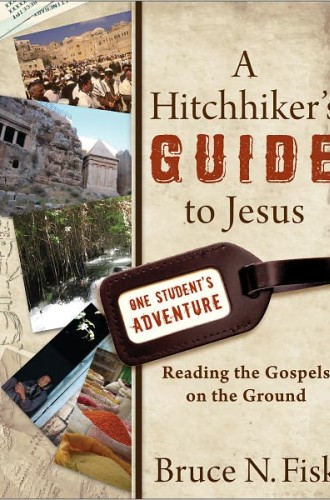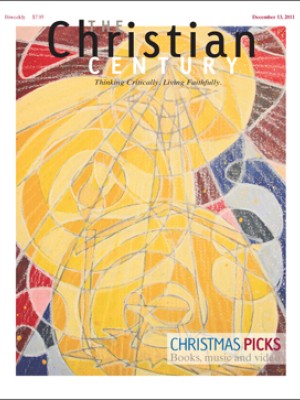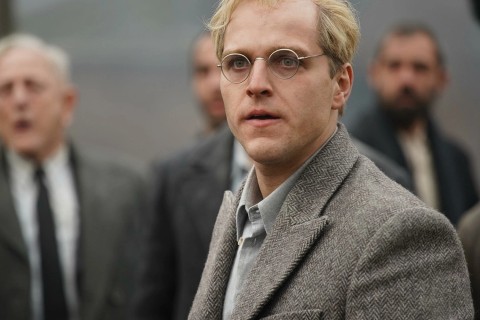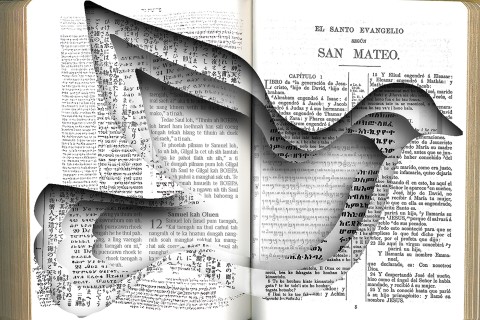Gospel journey
Is it even legal for New Testament studies to be this much fun? Grab your walking stick and follow along as recent college graduate Norm paces among the ruins of the Citadel, the ancient palace of Herod the Great at the western edge of the Old City of Jerusalem. Norm has a Christian background, a bachelor's degree in religion, and a head full of questions.
The young man is in Israel/Palestine on a backpacking caper to discover in situ what a self-respecting intellectual adult can believe about Jesus. Aware that Herod's palace eventually became Governor Pontius Pilate's residence, our hero finds three ancient steps among the ruins—a stairway that some believe once led to Pilate's judgment hall. If this is true, Norm broods, he is "standing near where Jesus stood when his death sentence was announced."
Read our latest issue or browse back issues.
This vignette comes from a book that is neither a novel nor a traditional introduction to the New Testament. With his imagination in overdrive, Bruce Fisk of Westmont College in Santa Barbara, California, has created the fictional character Norm (Fisk's alter ego?) to guide readers through today's Holy Land and into the thickets of New Testament scholarship. Norm's trip is imaginary, but it reflects insights Fisk has garnered on his own frequent travels in Israel/Palestine. The happy result is a travelogue-textbook that gives a satisfying overview of recent historical Jesus scholarship and provides a colorful introduction to archaeological treasures of the Holy Land.
As Norm makes the rounds to standard footsteps-of-Jesus sites (Nazareth, the Sea of Galilee, Gethsemane), he thumbs his Bible and recalls books or lectures on the New Testament that he encountered in college. As new questions emerge, he exchanges emails with his erstwhile college mentor, Professor Guilder, who provides a composite of what a good college-level New Testament prof ought to be teaching.
Intrepid Norm still wants to be a Christian, and he has a good grasp of scripture. But the faith of his childhood is twisting in the wind. During his Holy Land sojourn, Norm meets people who respond to his questions. In a streak of luck, he meets or otherwise engages John Dominic Crossan, James Dunn, Bart Ehrman, N. T. Wright and other luminaries of New Testament scholarship.
Archaeologist Jonathan Reed just happens to be making a film at Capernaum when Norm arrives. "Wire-rimmed glasses couldn't hide the sparkle in his eyes," Norm writes. In response to a question from Norm, Reed declares that houses in ancient Capernaum "were made of unhewn fieldstones, mud, wooden beams, and thatched roofs." Similar historical and archaeological details fill Norm's journals, and Fisk has taken pains to ensure that they are accurate.
Precocious Norm puts questions to the entire pantheon of scholars he engages, creating a nonthreatening way for Fisk to address conundrums that many Bible readers struggle with: How much about Jesus in the Gospels is historically accurate? Can we trust the New Testament if its authors embellished their stories? Why did Jesus have to die? Can modern people believe in the resurrection? In assessing the reliability and authenticity of specific Gospel accounts, Norm judges by criteria familiar to critical scholars, including multiple attestation (if an account comes from more than one source, it is probably reliable) and embarrassment (if something would be awkward for the early church to note, the account is probably authentic).
In addition to mining insights from modern scholarship, Norm repeatedly meets local people who illuminate his understanding of scripture. A Palestinian man at Jenin explains how olive presses work—helping Norm later make sense of an olive press at Gethsemane. As our hitchhiker wrestles with inconsistencies and improbabilities in the Gospels, he eventually concludes that the evangelists were not "courthouse lawyers" but "nimble musicians trading riffs on a well-loved classic."
Determined to make sense of scriptural authority, Norm finds his critical faith by embracing paradox and mystery. Lesslie Newbigin, Norm recalls, "contends that both fundamentalists and liberals have embraced the Enlightenment lie that we must hold out for certainty." Our traveler's close examination of how the Gospels treat Judas leads him to conclude that "we have caught the evangelists in the act of interpreting history through the lens of Scripture." That is, the authors of the four Gospels made the players in the Jesus story fit the mold of well-known Old Testament stories and prophecies.
Along with his persistent quest for truth, Norm also has some good fun and experiences a few pratfalls. He smokes (tobacco, to be sure) from a hookah at a Palestinian refugee camp. Exhausted, he falls asleep inside a niche tomb in the Basilica of the Holy Sepulchre in Jerusalem and is awakened by startled tourists. Norm falls in love with the "Mona Lisa of Galilee," a famous third-century mosaic at Sepphoris. Unsure how long he slept with his face in a book at the library of the École Biblique in Jerusalem (which he frequents for scholarly resources), he observes that the "puddle of drool on the page wasn't pretty." Such whimsical reports occur throughout Norm's account, providing relief from the earnest pursuit of truth and justice.
Though he doesn't belabor issues related to the present Israel-Palestine conflict, Norm is disturbed by mistreatment of Palestinians by the Israel Defense Forces. Palestinians who collaborate with the IDF as informers are the modern equivalent of Judas, he concludes. Jewish settlers in the West Bank remind him of the smug and oppressive Jewish priestly class of Jesus' day. Recalling Jesus' commitment to nonviolence, however, Norm is unimpressed by the glorification of martyrdom and terrorism that he sees among Palestinians in the West Bank.
Norm comes through his intense journey of doubt and inquiry with a kind of second naïveté, having "learned to trade away my tidy system for an unfinished, mystery-laden story." At the end of his trek Norm concludes that the historical Jesus was innocent but not innocuous, subversive but not seditious, a rebel but not a revolutionary, good but not safe. In reading back over his journals, Norm observes a "growing resolve to linger with the questions"—and implicitly invites the reader to do the same. Regarding Jesus' resurrection, Norm decides that "The Man" still "lurks at society's margins and lingers in its marketplaces." Norm had seen the risen Christ in the reconciliation work of Elias Chacour at Ibillin and in the tender care a Christian volunteer named Anna gave to disabled children at Tabgha by the Sea of Galilee.
Fisk does not pretend to make a leading-edge contribution to biblical research with this book; he's done that elsewhere. A Hitchhiker's Guide is the work of an effective teacher with creative pedagogy. Fisk's narrative, accompanied by actual readings from the scholars Norm ostensibly meets, will provide college students and others wanting a basic introduction to the Gospels a winsome way to learn. Anyone visiting Israel/Palestine or seeking a quick overview of historical Jesus studies will also benefit from Norm's journals.
This semifictional approach to New Testament study is risky, but it works. Fisk is a careful academic who knows and mines his sources, and he presents a range of scholarly insights with respect and clarity. A decent bibliography in A Hitchhiker's Guide provides good leads for further study, and more than 200 endnotes buttress specific comments and events so the reader can confirm that Norm's pilgrimage is reliable.







